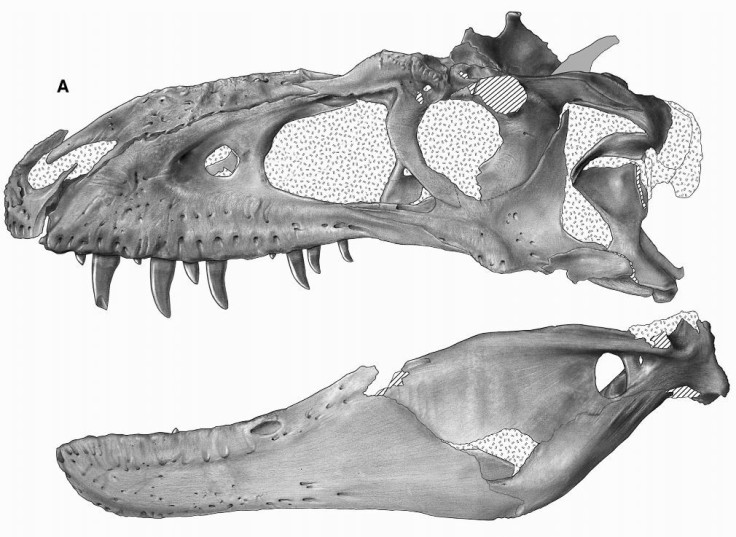Tyrannosaur Skull’s 3D Scan Shows How Top Dinosaur Predator Evolved

The inside of a tyrannosaur skull has clues about how the most famous dinosaur and its powerful teeth evolved, according to researchers who used 3D imaging to scan the fossil.
They took a high-energy CT scan of a 74-million-year-old skull that came from a dinosaur dubbed the Bisti Beast, which was found in northwestern New Mexico about 20 years ago and is related to the Tyrannosaurus rex, the Los Alamos National Laboratory reported, calling the work the highest resolution scan scientists have ever taken of a tyrannosaur. The skull needed high-energy imaging because it is so thick and the work gave them a closer look at the skull structure, including in the sinus and the brain cavities. The scan revealed impacted teeth hidden in the jaw and the pathways that some nerves and blood vessels took in the 3.5-foot-long cranium.
“The results add a new piece to the puzzle of how these bone-crushing top predators evolved over millions of years,” the New Mexico laboratory said. “The team’s study illuminates the Bisti Beast’s place in the evolutionary tree that culminated in Tyrannosaurus rex.”
This Bisti Beast, whose real name is Bistahieversor sealeyi — which is just as intimidating, since it translates to Sealey’s Badlands Destroyer — lived about 10 million years before the T. rex and some of its bones, in particular the skull, show differences from later tyrannosaurs. It was slightly smaller than its more famous relative, for example.
“When we take all these features together, it's clear that we have something different than what's been seen before,” Thomas Carr one of the paleontologists who studied the tyrannosaur, told Live Science in 2010, when he co-authored the study in the Journal of Vertebrate Paleontology that first described it. Because the Bistahieversor shares features of both more primitive and more advanced tyrannosaurs, “our animal is a window on what that common ancestor might have looked like.”
During the scanning process, the skull was so long that the researchers had to take multiple images and combine them, the lab described in a newsletter.
“Normally, we look at a variety of thick, dense objects at Los Alamos for defense programs, but the New Mexico Museum of Natural History and Science was interested in imaging a very large fossil to learn about what’s inside,” the lab’s Ron Nelson said in a statement. “It turns out that high energy neutrons are an interesting and unique way to image something of this size.”

It’s not the first time researchers have used new technology to look at old bones — earlier this summer scientists reported using CT scans to look into a megalosaurus fossil that was discovered 200 years ago, long before such advanced imaging existed. Inside they found previously undiscovered teeth and marks from restoration work that had been done on the dinosaur specimen.
According to Los Alamos National Lab, the scientists are expected to present more detailed results for the Bisti Beast at the annual Society of Vertebrate Paleontology meeting this month in Canada.
“The CT scans help us figure out how the different species within the T. rex family related to each other and how they evolved,” museum Curator of Paleontology Thomas Williamson said in the lab’s newsletter. “The Bistahieversor represents the most basal tyrannosaur to have the big-headed, bone-crushing adaptations and almost certainly the small forelimbs. … Bistahieversor lived almost 10 million years before T. rex, but it also was a surviving member of a lineage that retained many of the primitive features from even farther back closer to when tyrannosaurs underwent their transition to bone-crushing.”

© Copyright IBTimes 2024. All rights reserved.





















